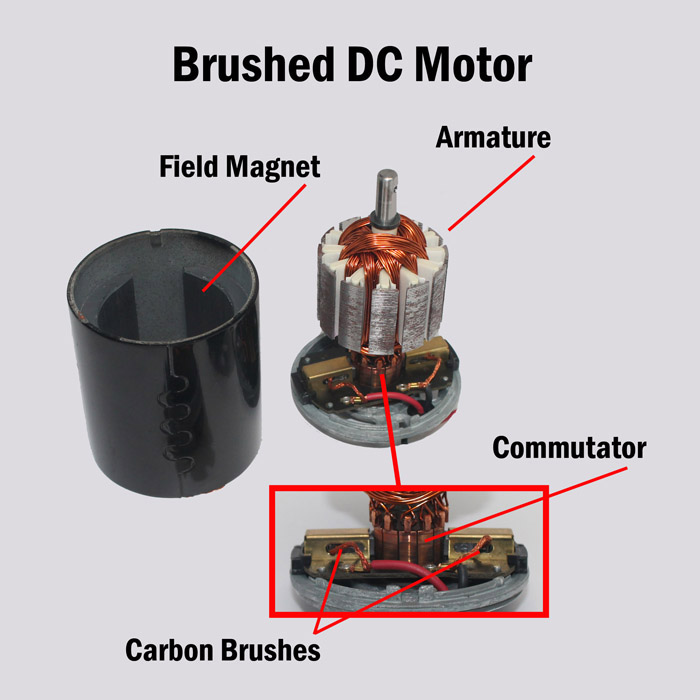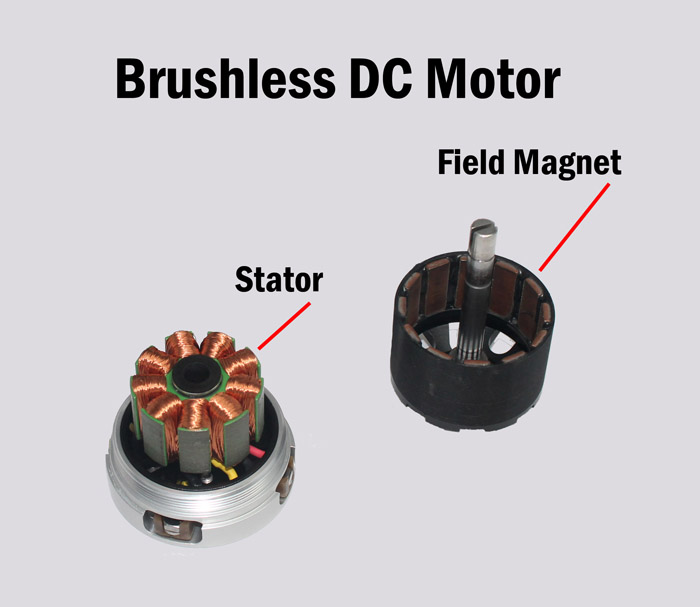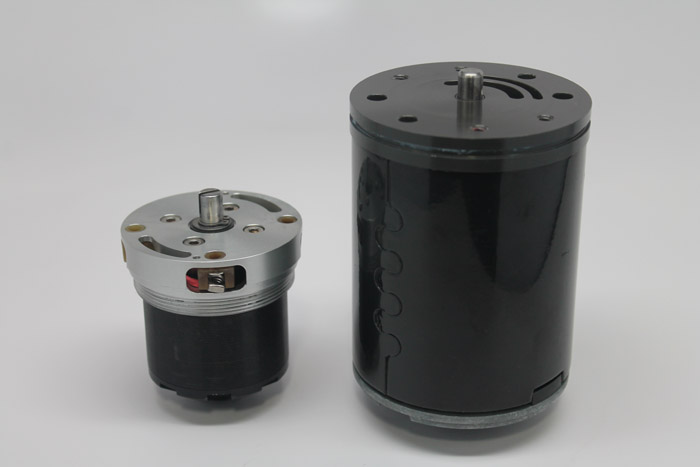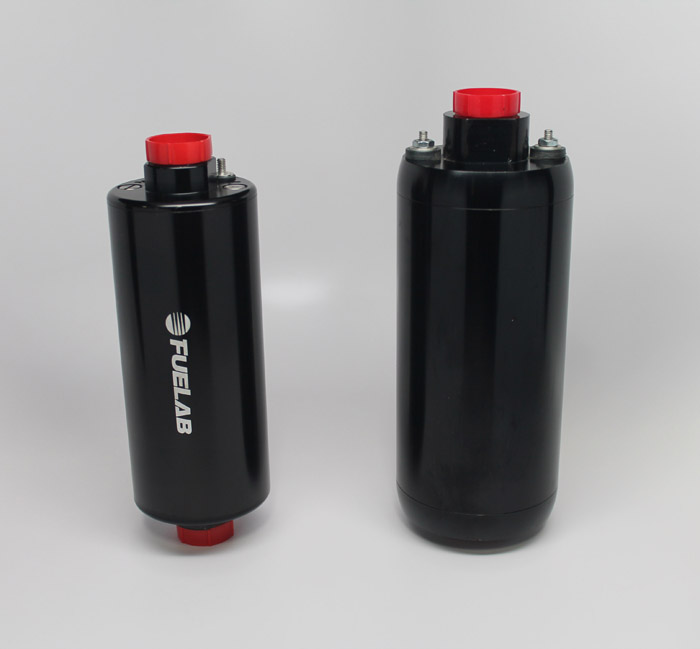Fuel Pump Motor Technology: Brushed DC Motors vs. Brushless DC Motors
FUELAB is proud to be the innovator of brushless and speed controllable fuel pumps in the automotive aftermarket. Our Prodigy Series of fuel pumps feature brushless electric motors for efficiency, long-life and reliability. Prodigy also features Digital Variable Speed Control that matches fuel flow to engine demand, keeping fuel cooler, and helping to avoid vapor lock and cavitation damage. Please note; this article will delve into motor technology, while a future article will detail the function and benefits of FUELAB’s Digital Variable Speed Control. Why did FUELAB choose use of brushless motors, rather than brushed motors? To answer this question let’s first explore the design and operation of a brushed DC motor, and a brushless DC design.
Design and Operation of Brushed and Brushless DC Motors Brushed DC Motor A DC Brushed Motor is comprised of four fundamental components: an armature (which holds wire motor windings, and magnets), a ring of magnets (or field magnet), carbon brushes, and a commutator. The ring of magnets and the brushes are non-moving, while the armature and commutator rotate together on the motor shaft within the field magnet. The armature is an electromagnet, and the ring of magnets is a permanent magnet. The commutator is a split-ring component which is wrapped around the motor shaft and contacts the brushes, which are connected to opposite poles of the power source. The brushes charge the commutator/armature inversely in polarity to the ring of magnets, which causes the armature to rotate. Thereby turning the motor shaft and providing propulsion to that which the motor is driving.  Brushless DC Motor With a DC Brushless Motor there is no armature. Rather, the wire motor windings (called a Stator) are non-moving, and are “hard wired” to the power source. The field magnet rotates and is directly connected to the motor output shaft to provide propulsion. The layout of a DC Brushless Motor can vary depending on whether it is in “Outrunner” style or “Inrunner” style.
Brushless DC Motor With a DC Brushless Motor there is no armature. Rather, the wire motor windings (called a Stator) are non-moving, and are “hard wired” to the power source. The field magnet rotates and is directly connected to the motor output shaft to provide propulsion. The layout of a DC Brushless Motor can vary depending on whether it is in “Outrunner” style or “Inrunner” style.
- Outrunner – The field magnet is a drum rotor which rotates around the stator. This style is preferred for applications that require high torque, and where high RPM isn’t a requirement.
- Inrunner - The stator is a fixed drum in which the field magnet rotates. This motor is known for producing less torque than the Outrunner style, but is capable of spinning at very high RPM.
DC Brushless Motors are more complex than DC Brushed Motors in the way the motor is charged. In the case of a brushed motor the brushes simply charge the commutator/armature inversely in polarity to the ring of magnets, which causes the armature to rotate. With a brushless motor a small circuit board coordinates the energy delivery to the windings to charge them inversely in polarity to the field magnet.  Above: Outrunner Style Brushless DC Motor Now, let’s compare Brushed and Brushless DC Motors. Brushed vs. Brushless DC Motors
Above: Outrunner Style Brushless DC Motor Now, let’s compare Brushed and Brushless DC Motors. Brushed vs. Brushless DC Motors
- Magnets
Brushed DC Motors typically use ceramic (Ferrite) magnets, which are composed of strontium carbonate and iron oxide. The benefit of ceramic magnets is their high resistance to corrosion and low cost. The down side is their moderate magnetic strength, and that they are brittle and easily broken. Brushless DC Motors typically use Neodymium magnets, which are composed of an alloy of neodymium (rare earth metal), iron and boron. Neodymium magnets produce significantly stronger magnetic fields than ferrite magnets, and are the strongest and most affordable type of rare-earth magnet. Neodymium magnets have a higher magnetic density which allows more power from a smaller motor. The negatives are they are relatively more expensive than ceramic magnets, they rust easily and extra steps must be taken to protect them from corrosion, and they also are brittle and will crack under stress.
- Conductive Efficiency
Brushed DC Motors are not as efficient conducting electricity as brushless motors. Due to the interface of the carbon brushes (less efficient a conductor than copper) and the copper commutator, a voltage drop is created. Brushless DC Motors are “hard wired’ to the power source. The copper on copper connection doesn’t cause a significant voltage drop.
- Friction
Brushless DC Motors don’t experience loses attributed to the friction of brushes dragging on a spinning commutator. Even though brushes are made from carbon for lubricity, friction still exists, thereby reducing the energy efficiency of brushed motors.
- Motor Longevity and Reliability
Since Brushless DC Motors have no brushes to wear out their service life is greatly extended as compared to a brushed motor, which extends the reliability of the motor over a longer period of time. It should be noted that the brushes of some brushed motors can be replaced, which can extend the life of the motor overall. However, the chance for motor failure due to brush wear is eliminated with a brushless motor.
- Size/Weight
As previously mentioned, neodymium magnets have a higher magnetic density which allows more power from a smaller motor. Therefore, the Brushless DC Motor used for a particular output need can be smaller and lighter than its brushed counterpart.  Above: The Brushless DC Motor (left) is a fraction of the size and weight of the Brushed DC Motor, yet the power output is significantly higher at about ½ H.P. vs. 1/3 H.P.
Above: The Brushless DC Motor (left) is a fraction of the size and weight of the Brushed DC Motor, yet the power output is significantly higher at about ½ H.P. vs. 1/3 H.P.
- Submergibility
While in operation Brushed DC Motors should not be submerged in some fuels as it can cause premature brush wear and failure. This is especially so with diesel applications: ultra-low Sulphur content fuel has low lubricity. Brushless diesel fuel pumps are typically designed with a shaft seal to ensure fuel doesn’t submerge the motor. These seals often wear and fail, allowing fuel leakage into the motor bearings, which is one of the main reasons for brushed diesel pump failure. Brushless DC Motors can be submerged in fuel during operation without issue. So, brushless pumps have no need for a shaft seal, thereby allowing them to be longer lasting and more reliable. Submersion capability also allows for liquid cooling of the motor – which is especially beneficial for a small, high energy motor that can generate much heat. For gasoline applications a benefit of submergibility is that the gasoline helps keep internal components from corroding. In a brushed system the non-submerged motor could be exposed to water and such – causing corrosion. Conclusion FUELAB decided to use Brushless DC Motors in our fuel pumps as the overall efficiency, long-life and reliability the technology offers is superior to that of brushless motors. Further, since more power can be obtained from a lighter motor, our fuel pumps are lighter, and they can provide more flow than a similarly sized fuel pump with a brushed motor.  Above: The pump on the left is a FUELAB pump with a maximum power usage at about 1/2 H.P., and the other is competitor’s brushed pump with a maximum power usage at about 1/3 H.P. Our pump without brackets weighs in at 2.40 lbs., and the brushed pump weighs 4.98 lbs. However, because the FUELAB pump is much more efficient it is rated at 190 GPH, while the other pump is rated at about 90 GPH.
Above: The pump on the left is a FUELAB pump with a maximum power usage at about 1/2 H.P., and the other is competitor’s brushed pump with a maximum power usage at about 1/3 H.P. Our pump without brackets weighs in at 2.40 lbs., and the brushed pump weighs 4.98 lbs. However, because the FUELAB pump is much more efficient it is rated at 190 GPH, while the other pump is rated at about 90 GPH.

You must login to post comments.